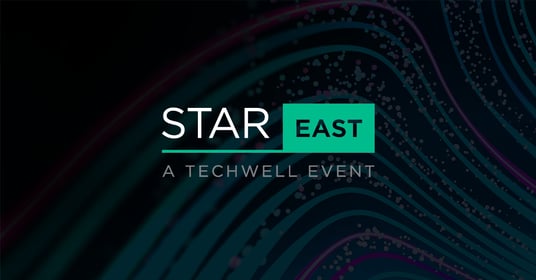Get a Free Trial
Creating, executing, and maintaining reliable tests has never been easier.
Recently, the mabl team joined StarEAST in person for the first time in two years. It was an incredible experience seeing so many friends from the QA community face-to-face: thanks to everyone who attended and the TechWell team for organizing the event.
We were also fortunate to host a panel of quality leaders driving the adoption of quality engineering, a discipline that incorporates best practices and data-driven software testing into the end-to-end customer experience and supports business growth:
- Jessica Mosley, Senior QA Specialist at Enbridge
- Amanda Ellison, QA Manager at Auction Edge
- Iryna Suprun, Director of Engineering Quality at Xandr
- Darrel Farris, Solutions Engineering Manager at mabl
The panel shared their real-world perspectives on the state of quality engineering, what practices drive real change, and how quality assurance teams can evolve to meet growing customer needs.
Darrel Farris was joined by a panel of quality experts at StarEAST 2022
Quality Engineering Requires A Culture of Quality
Despite their different backgrounds and industries, our panelists agreed on one core message: quality engineering requires a culture of quality throughout the organization. The concept of quality engineering itself is not new: Gartner began tracking the concept several years ago. But evolving the three facets of development culture - people, processes, and technology - requires a sustained effort and focus from the entire team. Adopting quality engineering means evolving each of these pillars to create a culture of quality
The end result is a software development organization focused on the customer experience, eliminating the divide between the people who build a product and the people who use it. As Iryna stated during the StarEAST session: “A culture of quality is a culture of customer satisfaction”.
Empowering QA to Lead Transformation
Quality is ultimately judged by the customer, and rarely in terms of pass/fail like traditional software testing. Iryna noted that the new definition of quality goes beyond ensuring that the product works as expected to consider if the customer is truly satisfied while using the product.
She explained her team’s mindset: “Are they [the customer] happy to use our product? Do they feel good? Are their needs fulfilled? If not, then it doesn’t matter how many bugs you have in your code.”
As the common thread throughout development in a culture of quality, QA needs to be empowered to advocate for the customer experience at all stages of the software development life cycle. For Jessica, this meant hosting a week-long “Quality Matters” event at natural gas distribution company Enbridge, which featured a hackathon to help the entire organization understand how their work fits into the customer experience. This helped build awareness for how quality impacts the overall business and gave her quality team a chance to lead critical conversations about how everyone can contribute to user happiness.
Quality Engineering Enables Faster Software Development
Jessica also spoke about a common challenge for quality teams driving the quality engineering transformation: colleagues that are reluctant to change their existing workflows. They’re often initially suspicious and question the changes: “Are you implementing this to critique me? To block me? Are you going to stir up trouble?”
Based on mabl’s 2021 Testing in DevOps Report, she’s far from alone. The most common challenge cited by respondents was the slow process of change. Iryna shared that many development teams worry that expanding their quality engineering practices will hinder product velocity. But her experience - and industry data - show the opposite is true. Improving software testing in development actually helps development teams move faster.
44% of software developers say that fixing defects is their biggest pain point, with 52% saying that they would rather use the time spent resolving defects to build new features. Embracing quality engineering is a proven strategy to help developers shift their focus from reactive fixes to innovating. 62% of DevOps teams with a culture of quality say that they’re able to fix bugs within eight hours, compared to the 20% of teams with siloed testing practices who report needing two days to resolve issues. The key difference is that DevOps teams are much more likely to be practicing continuous testing in a culture of quality, so defects are identified earlier.
AI and Low-Code are Unlocking High Impact Test Automation
The final piece of the puzzle, technology and tools, helps QA teams maximize their work so that they have the capacity to lead organizational change and adopt better processes like continuous testing. Amanda explained that her team is focused on building a culture of quality from the top-down, and doing so requires solutions that enable QA to “bring everyone into our sandbox - help everyone talk about quality from the customer experience, and what the user actually experiences on a day-to-day basis.” With low-code intelligent test automation, Amanda’s team is able to empower the whole organization to have a stake in the Action Edge quality strategy.
Darrel noted that this democratization of quality shouldn’t be limited to certain team members, saying that “not everyone who cares about quality can necessarily write code or should.” But even experienced test engineers can benefit from low-code test creation, as Darrel noted from his own experience as a software tester. “[Low-code] allows testers to separate the intent of what you're trying to test from the actual implementation of the test. You can think about the product and customer outcome, which is where I want my head to be.”
If low-code simplifies the test creation process, intelligent features like auto-healing further support testers to focus on verifying the user experience by reducing the amount of effort needed to maintain tests. Iryna shared Xandr’s experience:
“We had complex end-to-end scenarios, and were struggling to automate them - essentially spending more time trying to figure out how to implement our tests instead of focusing on the user experience. Mabl really helped us automate those user journeys and expand testing to better reflect the customer experience.”
When quality teams have the right solutions for software testing designed for quality engineering, they’re empowered to create effective quality practices that support organizational change. As our panelists noted throughout the StarEAST session, the state of quality engineering is one of transition, transformation, and momentum. When quality teams lead, development teams can move faster and customers have better experiences.
Start your quality engineering journey with mabl’s two week free trial and see how low-code, intelligent test automation can empower your team.






